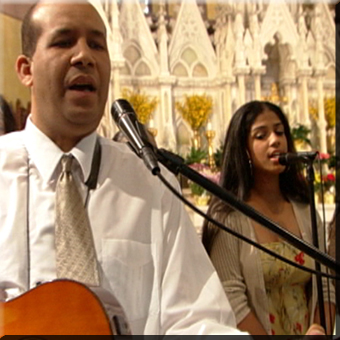The U.S. Catholic Church today is undergoing profound cultural, social, and leadership transitions. It’s at the parish level that conflicts arise and new pastoral approaches are created.
Three Catholics—one white, one Hispanic, and one Vietnamese—walk into a church on Sunday. (If you thought that I was going to say that they walked into a bar, I know a few of those stories as well.) These Catholics and their families are members of St. Patrick Parish in Lawrence, Massachusetts, which serves Catholics in three different languages: English, Spanish, and Vietnamese.
St. Patrick’s has been my home parish for nearly a decade. My wife and I came to the parish to work in Hispanic ministry, and from the time we arrived until now it has been a source of transforming experiences.
St. Patrick’s experience is not unique. In parishes throughout the United States today, families from different ethnic and cultural backgrounds come to the same church to celebrate the sacraments and to nourish their faith in different languages. They are active members of the same community while belonging to networks of relationships shaped by their particular cultural traditions.
That such multicultural parishes are becoming more and more common, of course, does not mean that no tensions arise, but these are natural to the transitions that these communities are undergoing.
This is not the first time that the American Catholic experience has been deeply transformed by cultural diversity; neither will it be the last. Many older Catholics still remember the vibrancy of national parishes, where families celebrated their faith in their own languages and affirmed their varying cultural identities. These close-knit, almost independent communities shaped the identity of millions of European-born Catholics and their descendants.
By the middle of the 20th century millions of American Catholics moved out of their close-knit neighborhoods and joined middle-class society. Access to higher education, a more professional workforce, and deep changes in the life of the church helped shape a new phase for Catholicism.
Catholics employed a stronger voice in society, their schools became highly respected, their political presence increased significantly, and whole families transitioned into the middle class. That transition meant greater social and political participation and was about being both fully Catholic and fully American.
In the past 10 years, we have witnessed the acceleration of a profound demographic shift. Only five decades ago the vast majority of Catholics in the country shared a mostly European American background. Today the U.S. Catholic landscape looks quite different. Approximately 2.7 percent of U.S. Catholics are Asian and Pacific, 3.7 percent are African American, and the fastest growing group is that of Hispanic Catholics, who already make up 40 percent (possibly more) of the total American Catholic population. It is estimated that in about 15 years half of all U.S. Catholics will be Hispanic.
Clearly the church in the United States is undergoing rapid and profound changes that are already transforming the cultural, social, and religious identity of Catholics. While some are determined to replicate or to hold on to past models of being church, such attempts will only prevent us from being creative in responding to the challenges of our times.
In today’s church I see three major transitions that require attention
1. Cultural transition
As U.S. Catholicism is rapidly moving from a European American cultural experience to one that is largely Hispanic and multicultural, celebrating liturgies in two or more languages while integrating different cultural traditions has become increasingly common. However, similar to the nativist calls for “English only” policies in the larger society, this development has caused some parishioners to demand that Mass be celebrated in English—in what they define as the “traditional way.”
Even if it is true that U.S.-born generations of Hispanics are already integrating into a commonly shared experience, this does not mean that they should have to abandon their cultural traditions and their families’ languages. Different cultural practices, symbols, and languages can profoundly enrich the common Catholic liturgical experience, and we should be creative in integrating them.
Only 12 years ago St. Patrick Parish served primarily Catholics of Irish ancestry in a city where more than 70 percent of the population was Hispanic. Today, implementing the city’s pastoral plan, St. Patrick offers Mass in Spanish—as do all Catholic parishes in Lawrence—as well as in Vietnamese.
Holy Week services were initially celebrated in separate languages, but pastoral leaders soon agreed that moving toward bilingual rituals was the most appropriate way to foster and express the unity of the community in worship.
When the change was announced, a number of parishioners protested, saying they would never attend bilingual services. Some of them went to other parishes.
“I do not know Spanish, and I was not getting anything out of these celebrations,” remembers Sister Sheila Buckley, a Sister of Charity who was born in Lawrence, received all her sacraments at St. Patrick, and taught at the parochial school for several decades. “Mass is very important to me, and I did not want to miss what was happening, especially the readings. Why should I go to a Mass in a language that I did not understand?”
The pastoral team committed to planning services that honored the beauty of the liturgy while integrating some cultural traditions and Spanish- and Vietnamese-language texts into these liturgies. The team strove to not make it exceptionally burdensome to parishioners.
Although initially somewhat reluctantly, Buckley, along with hundreds of parishioners, decided to attend the multilingual services during Holy Week. She has gained a better understanding not only of the liturgy, but also of her community. “People are good,” she says. “We all are trying to get closer to God.”
Today hundreds of parishioners look forward to the various multilingual services, while others are still struggling with this transition.
In this cultural transition it is important for parishes to honor the religious practices that are central to the spiritual life of each of their groups. European American Catholicism is very rich in its devotional traditions, and much more could be done to revitalize those practices.
Hispanic Catholics and other groups coming to parishes throughout the country bring the vibrancy and spontaneity of popular Catholicism. Expressions of popular Catholicism—such as altarcitos (little home altars), Passion reenactments, and Marian devotions—nourish and sustain the spiritual lives of millions of Catholics.
Pastoral leaders must learn what practices relate best to the experiences of the people they serve. At St. Patrick, parish leaders first instituted a celebration of Our Lady of Guadalupe as a way to encourage the Marian devotion of Hispanics. However, since most Latinos in the community are from the Dominican Republic and Puerto Rico, not many responded to that invitation.
For Dominicans and Puerto Ricans Our Lady of Guadalupe does not have the same appeal as she does among Mexicans. Today the two most popular Marian celebrations in the parish are the feast of Our Lady of Altagracia (protector of the Dominican Republic) and the feast of Our Lady of the Divine Providence (patroness of Puerto Rico).
2. Social transition
In the middle of the 20th century U.S. Catholicism moved from neighborhood enclaves into mainstream society. Many Catholic families are now solidly middle class. But not all Catholics have “made it.” Millions of them do not experience the middle-class benefits of education, professional achievement, and economic stability.
Most Catholic immigrants are not middle class and lack the social and economic stability of their fellow Catholics. Because they constitute the fastest-growing sector among Catholics in the country, the church’s social transition back to the barrio and the city is deeply reshaping the identity of the Catholic experience in this country.
The church as a whole needs to reassess its priorities. Middle-class Catholicism is declining in numbers and influence in our society, while Catholicism as a whole continues to grow. It is tempting to switch to “survival mode” to save the little stability gained a few decades ago. It seems easier to cling to the securities already in hand than to venture into the difficult task of helping poor Catholics deal with their many needs. But I don’t think these options reflect the way of Jesus.
U.S. Catholicism in the 21st century will thrive not by looking with nostalgia at a glorious past but by embracing the present and the future and by renewing our ministries to the poor and the marginalized.
In 2006 St. Patrick Parish opened its Cor Unum Meal Center to provide meals to poor people. Most of the Cor Unum guests are poor Catholics from many different ethnic backgrounds.
The parish built the meal center against significant odds and resistance. Many parishioners thought that it was an “unnecessary” financial risk. Others opposed the idea because of the kind of people it would attract—hungry, poor families. Still others thought that it would simply fail.
Today Cor Unum feeds more than 400 hungry people every day (including entire families), does not cost the parish one cent, is run by more than 500 volunteers and only one staff person, receives donations from dozens of businesses, and has turned out to be a great opportunity through which hundreds of people meet Christ in the other. Clearly Cor Unum was the right choice.
Susie Pino migrated from Ecuador almost a decade ago. Soon after her arrival she found work in a factory where she earned the minimum wage. Though this was not much, it was enough for her to make ends meet at home, where she lives with her 10-year-old son. She heard about St. Patrick Parish and joined the community.
When the parish built the meal center, Pino felt compelled to serve as a volunteer. There she helped to serve free meals to some of the poorest people in the city, many of them children. Little did she know that the economic crisis would leave her unemployed—and poorer herself. Now she and her son are regular guests at Cor Unum, where she continues to serve as a volunteer.
“There are many people who are in the same situation as I am, and I think that I can help,” says Pino, speaking in Spanish. At Cor Unum Catholics continuously discover new ways of living out their faith. It has led Pino to reassess her thinking: “It is really hard not to have money to buy food for me and my son and to pay the rent. Sometimes I ask where God is in all this, but when I come to Cor Unum and see what people do for one another, I begin to get some answers to my questions.”
Ministry in the large cities and the barrios requires church leaders to learn about the reality of people living in the margins of society. It requires them to learn the many languages with which Catholics articulate their faith experiences. And it requires the revision of “traditional” models of ministry, the setting aside of preconceived theories, and the impact of pastoral models and resources imported from other countries.
Understanding the current profound transition must lead us to question the allocation of resources assigned to serve the spiritual and social needs of Catholics living in barrios and poor neighborhoods. In many places they are the majority. But where are our pastoral centers located? What portion of our budgets is assigned to, for instance, Hispanic ministry? And why are dozens of inner-city Catholic schools being closed precisely at the time when Hispanic Catholics double and triple in numbers around them? Are there really no alternatives?
3. Leadership transition
The current transformation of the church is a unique opportunity for all Catholic leaders to rethink current models of ministry that may not effectively respond to the challenges of working in culturally diverse contexts.
Some church leaders seem to be placing all of their bets on assimilation into “mainstream” Catholicism. Yet Hispanic and other ethnic groups are forcing the church to envision new ways of being Catholic that can integrate the richness of their many cultural experiences. Even Catholics of European backgrounds are increasingly reclaiming their cultural roots. This is great.
Other church leaders feel more comfortable with models that segregate ethnic and language groups in their own communities. Unfortunately, this solution is both counterproductive to the common good of the Catholic community and limits the impact of minority leaders’ contributions to the larger community.
As the number of Hispanic Catholics has been rapidly increasing in the pews, such growth is not equally reflected at all levels of leadership in the church. In some sectors of our church there has been a lack of clear commitment to fostering leadership among Hispanic Catholics. This has contributed to the unfortunate perception of the Hispanic presence as merely an addendum or secondary concern.
That inadequate attitude, often expressed in tokenism, translates into little or no consultation at the decisive stages of projects that affect the larger church community, participation in the planning processes that look at the present and future of ministry, and attention to the plurality of voices and experiences that Hispanic Catholics bring to the table.
St. Patrick is not a perfect community where all leadership issues have been resolved. Some good steps have been taken while adjustments need to be made to continue our growth. One model that has worked well in the parish has been the openness to collaborative ministry that clergy and lay ministers have embraced.
In Hispanic ministry my wife, Guadalupe, and I work alongside the two parish priests and the rest of the pastoral staff in serving the needs of all Catholics in the community. Each leader values the strengths of the others and brings his or her own unique perspective to the table.
Father Paul McManus, the parochial vicar, spent five years as a missionary priest in Ecuador. Our pastor, Father Paul O’Brien, has lived in Italy and has done missionary work in India. Guadalupe is a Latina raised and educated in the United States. And I was born in Latin America, where I was active in ministry, and I have worked with Hispanic communities in the United States for more than a decade.
For all of us at times it has been tempting to impose our own ideas about what “should be,” but working together as a team has led us to realize that Hispanic ministry always has to be shaped by the unique circumstances of Hispanics in this country as well as those of the larger Catholic community. There is no one-size-fits-all approach to Hispanic ministry.
St. Patrick’s, along with the rest of the church, is affected by larger concerns such as the clergy shortage and financial pressures. What distinguishes our parish from others is that the conversation about leadership in a time of transition has at least begun, that most groups in the community are actively involved in this conversation, and that together parish leaders have accepted the responsibility to search for the best pastoral models to serve a trilingual community. This is almost half the job.
Into the future
Throughout the United States the Catholic Church today needs to seriously reflect on what it means to be Catholic in the 21st century and respond to the challenges that are being posed by these three transitions in our parish communities. We are a culturally diverse body, and all models of ministry and theological reflection need to be responsive and responsible to this reality of diversity.
In the midst of these transitions, the idea of Hispanic ministry is also being transformed. In many places to speak of Hispanic ministry is to speak simply of ministry, and vice versa. U.S. Hispanic Catholics are in a unique position today to assume more responsibility in building communities and institutions that serve the needs of all groups in the church.
We recognize that we need to work together with all other groups of Catholics. And in turn, all other sectors in the church must recognize that Hispanic voices and contributions are essential and indispensable to the American Catholic experience today.
St. Patrick’s is a good example of a parish that is currently undergoing cultural, social, and leadership transitions. We still have a lot to learn from other communities that have already gone through these transitions, while at the same time we can share some of what we have learned with those who are just beginning the process.
Considering the trends in demographics, very few Catholic parishes in the United States will remain unchanged during the next two decades. This is why any time our white, Hispanic, and Vietnamese friends come to St. Patrick’s with their families, they participate in an experience that is deeply transforming American Catholicism.
This article appeared in the June 2010 issue of U.S. Catholic (Vol. 75, No. 6, pages 17-21).
Image: James Rutenbeck, Scenes from a Parish














Add comment